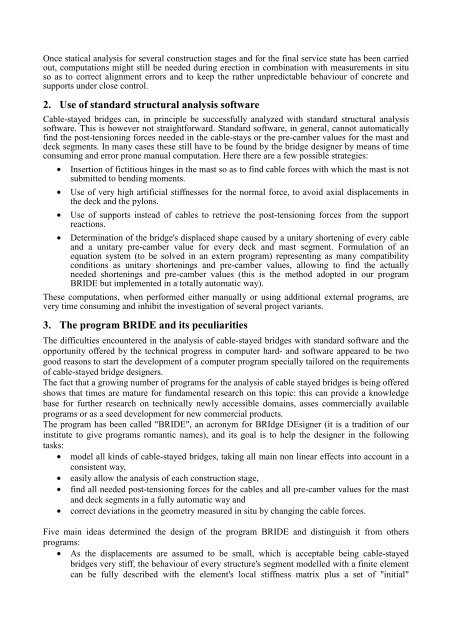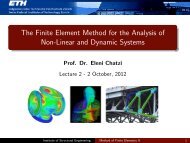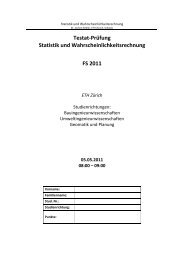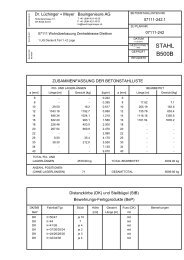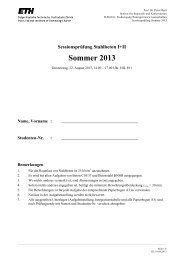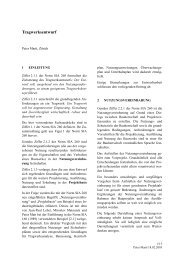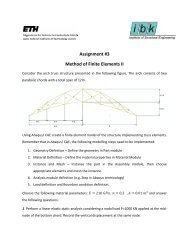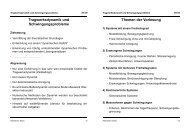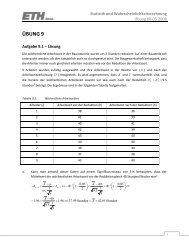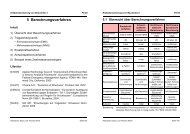A New Program for the Design of Cable-Stayed Bridges Summary 1 ...
A New Program for the Design of Cable-Stayed Bridges Summary 1 ...
A New Program for the Design of Cable-Stayed Bridges Summary 1 ...
Create successful ePaper yourself
Turn your PDF publications into a flip-book with our unique Google optimized e-Paper software.
Once statical analysis <strong>for</strong> several construction stages and <strong>for</strong> <strong>the</strong> final service state has been carried<br />
out, computations might still be needed during erection in combination with measurements in situ<br />
so as to correct alignment errors and to keep <strong>the</strong> ra<strong>the</strong>r unpredictable behaviour <strong>of</strong> concrete and<br />
supports under close control.<br />
2. Use <strong>of</strong> standard structural analysis s<strong>of</strong>tware<br />
<strong>Cable</strong>-stayed bridges can, in principle be successfully analyzed with standard structural analysis<br />
s<strong>of</strong>tware. This is however not straight<strong>for</strong>ward. Standard s<strong>of</strong>tware, in general, cannot automatically<br />
find <strong>the</strong> post-tensioning <strong>for</strong>ces needed in <strong>the</strong> cable-stays or <strong>the</strong> pre-camber values <strong>for</strong> <strong>the</strong> mast and<br />
deck segments. In many cases <strong>the</strong>se still have to be found by <strong>the</strong> bridge designer by means <strong>of</strong> time<br />
consuming and error prone manual computation. Here <strong>the</strong>re are a few possible strategies:<br />
• Insertion <strong>of</strong> fictitious hinges in <strong>the</strong> mast so as to find cable <strong>for</strong>ces with which <strong>the</strong> mast is not<br />
submitted to bending moments.<br />
• Use <strong>of</strong> very high artificial stiffnesses <strong>for</strong> <strong>the</strong> normal <strong>for</strong>ce, to avoid axial displacements in<br />
<strong>the</strong> deck and <strong>the</strong> pylons.<br />
• Use <strong>of</strong> supports instead <strong>of</strong> cables to retrieve <strong>the</strong> post-tensioning <strong>for</strong>ces from <strong>the</strong> support<br />
reactions.<br />
• Determination <strong>of</strong> <strong>the</strong> bridge's displaced shape caused by a unitary shortening <strong>of</strong> every cable<br />
and a unitary pre-camber value <strong>for</strong> every deck and mast segment. Formulation <strong>of</strong> an<br />
equation system (to be solved in an extern program) representing as many compatibility<br />
conditions as unitary shortenings and pre-camber values, allowing to find <strong>the</strong> actually<br />
needed shortenings and pre-camber values (this is <strong>the</strong> method adopted in our program<br />
BRIDE but implemented in a totally automatic way).<br />
These computations, when per<strong>for</strong>med ei<strong>the</strong>r manually or using additional external programs, are<br />
very time consuming and inhibit <strong>the</strong> investigation <strong>of</strong> several project variants.<br />
3. The program BRIDE and its peculiarities<br />
The difficulties encountered in <strong>the</strong> analysis <strong>of</strong> cable-stayed bridges with standard s<strong>of</strong>tware and <strong>the</strong><br />
opportunity <strong>of</strong>fered by <strong>the</strong> technical progress in computer hard- and s<strong>of</strong>tware appeared to be two<br />
good reasons to start <strong>the</strong> development <strong>of</strong> a computer program specially tailored on <strong>the</strong> requirements<br />
<strong>of</strong> cable-stayed bridge designers.<br />
The fact that a growing number <strong>of</strong> programs <strong>for</strong> <strong>the</strong> analysis <strong>of</strong> cable stayed bridges is being <strong>of</strong>fered<br />
shows that times are mature <strong>for</strong> fundamental research on this topic: this can provide a knowledge<br />
base <strong>for</strong> fur<strong>the</strong>r research on technically newly accessible domains, asses commercially available<br />
programs or as a seed development <strong>for</strong> new commercial products.<br />
The program has been called "BRIDE", an acronym <strong>for</strong> BRIdge DEsigner (it is a tradition <strong>of</strong> our<br />
institute to give programs romantic names), and its goal is to help <strong>the</strong> designer in <strong>the</strong> following<br />
tasks:<br />
• model all kinds <strong>of</strong> cable-stayed bridges, taking all main non linear effects into account in a<br />
consistent way,<br />
• easily allow <strong>the</strong> analysis <strong>of</strong> each construction stage,<br />
• find all needed post-tensioning <strong>for</strong>ces <strong>for</strong> <strong>the</strong> cables and all pre-camber values <strong>for</strong> <strong>the</strong> mast<br />
and deck segments in a fully automatic way and<br />
• correct deviations in <strong>the</strong> geometry measured in situ by changing <strong>the</strong> cable <strong>for</strong>ces.<br />
Five main ideas determined <strong>the</strong> design <strong>of</strong> <strong>the</strong> program BRIDE and distinguish it from o<strong>the</strong>rs<br />
programs:<br />
• As <strong>the</strong> displacements are assumed to be small, which is acceptable being cable-stayed<br />
bridges very stiff, <strong>the</strong> behaviour <strong>of</strong> every structure's segment modelled with a finite element<br />
can be fully described with <strong>the</strong> element's local stiffness matrix plus a set <strong>of</strong> "initial"


